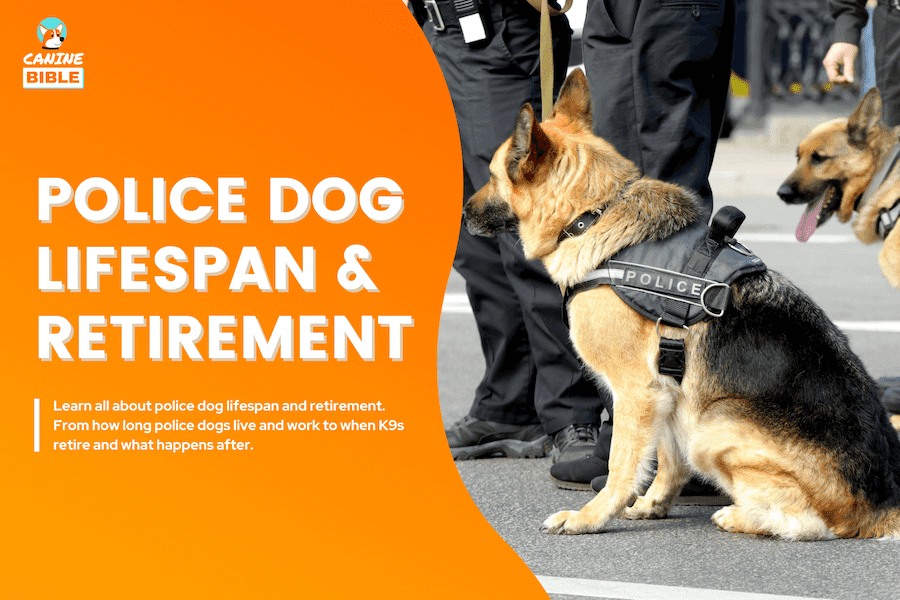Police Dog Lifespan: How Long K9s Work & Live? Retirement Age & Adoption

Canine Bible is reader-supported. We receive affiliate commissions via some of our links. This doesn’t affect rankings. Learn more.
How long are police dogs’ lifespans? At what age do police dogs retire? How long do police dogs work?
K9 life expectancy and retirement age cannot be accurately predicted. Police dog lifespan expectancy, or longevity, is defined as the expected number of years of working years in a K9 unit, and several factors affect how long a police dog unit works, lives, and when they retire, including dog breed, health status, job dangers, among others.
And if you are planning to adopt a retired police dog or work with one, there are important considerations to remember. Let’s dive right in!
- What Do Police Dogs Do?
- What Is The Average Police Dog Lifespan?
- Lifespan By Breed
- How Long Do Police Dogs Live?
- Factors Affecting Lifespan, Work & Retirement
- How To Extend Police Dog Lifespan?
- Size & Police Dog Lifespan
- Police Dog Retirement
- What Happens To Police Dogs When They Retire?
- Life After Retirement (Video)
- Adopting a Retired Police Dog
- Retired Police Dog Aid & Adoption Resources
- Caring For A Retired K9
- Police Dog Facts
What Do Police Dogs Do?
A police dog, also known as a K9 unit, is specifically trained to assist police and other law-enforcement personnel. These breeds have outstanding working abilities and a strong desire to cooperate with their handlers. Some police dogs are solely trained to perform one task. Others are trained to be multitaskers. But what exactly do police dogs do? They are mainly used for apprehension, detection, and search and rescue. For instance, K9 units search for drugs and explosives, locate missing people, find crime scene evidence, and attack people targeted by the police.
Police Dog Lifespan Expectancy
So, when do police dogs retire? How long do k9 dogs work?
How Long Do Police Dogs Work?
According to the National Police Dog Foundation, a dog’s age when they can begin to work as a police dog is between 12 and 15 months (roughly 1.3 years). That’s usually when dogs reach maturity and can concentrate on training.
The working lifespan of a police dog can vary depending on various factors, such as breed, health, and the type of work they do. However, the average working lifespan of a police dog is roughly 8 to 10 years from the moment they are enlisted to become a K9 officer.
What Age Do Police Dogs Retire?
How old is the average police dog when retired? Generally, police departments prefer to retire dogs around 9 years old, states K9 COP magazine. Some dogs may be able to work for longer, while others may need to retire earlier due to health issues or declining performance. Also, some breeds tend to have longer lifespans than others, which may delay K9 retirement in some cases.
Police Dog Lifespan By Breed
Here is a list of the most popular police dog breeds, along with their lifespan and possible age for retirement.
How Long Do K9 Dogs Live?
K9 dogs typically live between 8 and 10 years. Being a police dog is a very demanding and dangerous job that can affect the dog’s body and even its own life. Police dogs risk their lives every day and can die early on duty. We’ve seen fallen K9s that have passed at 3, 5, and 6 years of age.
Where Do Police Dogs Live?
Police dogs typically live with their handlers, their primary caretakers. This arrangement allows the handler to develop a strong bond with the dog and helps to ensure that the dog receives the necessary care and attention. It also allows the dog to be available for training and deployment when needed. In some cases, police departments may provide housing or kennel facilities for their K9 units. This can be particularly useful for departments with multiple dogs and handlers, as it allows the dogs to be housed in a secure and appropriate environment.
Factors Affecting How Long Police Dogs Live, Work & Retirement
Canine officers dedicate their lives to helping law enforcement fight crime, and just like human officers, police dogs face many safety risks on the job.
From the environment, maintenance, health, and whether the police dog is facing hazardous situations such as searching for explosives, all of these factors matter when thinking about a police dog’s life expectancy.
These are the most common factors that play into police dogs ceasing to work and what age the k9 retires.
Job Dangers
Police dogs risk their lives daily to protect and assist law enforcement personnel. Canine officers are often the first to enter dangerous situations. And in some cases, they are the first to be harmed by criminals and external threats such as explosives, gunshots, and drug overdose.
According to the Officer Down Memorial website, the most recent police dog casualty was a K9 officer named “Hondo.”[1] This brave pup was shot and killed while attempting to apprehend a wanted subject on Thursday, February 13, 2020. K9 Hondo was a Belgian Malinois and had served in law enforcement for over four years. He was seven years old when he passed away. RIP, beloved Kondo.
Training
Every shift holds a different danger for police dogs. A police dog’s performance and abilities to carry out his duties safely without endangering his well-being depend massively on training. A poorly trained K9 can make errors that cost lives, including their own. For instance, a canine officer unable to return to the handler on command 100% of the time may rush into a life-threatening situation.
If the dog doesn’t apprehend when commanded, an armed suspect may have a chance to open fire on him or human officers.
Poor Handling
The health, well-being, and lifespan of a police dog are directly affected by their handlers’ commands.
“Properly trained [police] dogs are like a switch; you turn them on and turn them off,” said Charles Mesloh, a criminal justice professor at Northern Michigan University in Marquette, who had been a K-9 handler in South Florida for ten years.
Police dogs depend on their handlers to give firm directions to do their job as safely as possible. An unprepared or shoddy handler of police dogs puts everyone at risk, especially their dog. Failure to properly handle a k9 unit may lead to unintentional bites, dogs being left behind in hot patrol cars, or leaving them vulnerable to being fatally attacked by criminals.
Maintenance
There are several costs associated with having K9 units on duty. A police department that lacks funding for training, equipment, payroll, and medical needs for the life of their police dog needs to address this immediately.
Not having enough money to train or care for the police dog properly may shorten a police dog’s lifespan, as this affects every aspect of a police dog’s performance in the line of duty.
Health
Police dogs can present interesting health challenges during their time as K9s. Police dogs with health conditions that hinder their abilities to perform their duties are entitled to retire sooner, thus cutting their lifespan as police dogs.
How To Extend Police Dog Lifespan?
If your K-9 just became a certified law enforcement canine officer, you are probably concerned about his life, health and well-being.
Some K-9 dogs stay on duty a lot longer than average, but the job demands make your dog age faster. Genetics partially determines a police dog’s lifespan, but the risks associated with being a police dog play a more significant role. However, you can make a difference by providing the best care possible.
Here are some things you can do as a police dog handler to increase the lifespan of your fur-ever friend:
Using Supplements
Other Tips
Size & Police Dog Lifespan
The larger the police dog, the shorter his working lifespan will be. Larger dog breeds age faster than smaller dogs.
In a study published in The American Naturalist journal led by the researcher Cornelia Kraus, an evolutionary biologist at the University of Göttingen in Germany, large dogs age at an accelerated pace, and “their lives seem to unwind in fast motion.” Scientists concluded that every 4.4 pounds of body mass reduce a dog’s life expectancy by about a month.[2]
Police Dog Retirement
Whether the police dog is 6 or 9 years of age, retirement talks for a police dog may begin sooner. Sending an impaired or injured dog to the field is cruel and can be fatal for everyone involved. Retiring a k9 dog is always based on the dog’s best interest.
What Happens To Police Dogs When They Retire?
So, where do police dogs go after they finish a police career?
Thanks to Robby’s Law, police dogs can be adopted by their handlers and even the general public. After retirement, most police dogs are adopted by their handlers.[3]
However, life may not always be easy for retired police dogs. It’s common for K9s to exhibit negative behaviors such as:
You are probably asking yourself: is adopting a police dog even worth it? It is, but it depends. Keep reading to learn what it takes to own a retired K9 and if it’s the right fit for you.
The Life of A Retired Police Dog
Watch how Bessie, a retired police dog, spends her days after serving in law enforcement.
Adopting a Retired Police Dog
If the original K-9 unit handler cannot adopt his furry police friend, other law enforcement officers will be first in line to adopt, followed by the general public.
Adopting a retired K9 is an excellent opportunity to give back to a dog whose job is to keep your community safe.
Here are a few things to consider before adopting a police dog.
If you’re considering adopting a retired police dog, your local police department is the best place to start your search.
Retired Police Dog Aid & Adoption Resources
The Retired Police Canine Foundation and the National Police Dog Foundation assist handlers with medical care, training for retired police dogs and other services to improve the lives of retired police dogs and owners.
Aside from your local police department’s Mission, K9’s “Adopt” page can be a valuable resource for connecting civilians with former working police dogs looking to be adopted.
Caring For A Retired Police Dog
Police dogs may require extra care as most of them are in their senior years or end their lifespan when they retire. A common health issue they face is joint problems. Retired K9s are highly trained, so you’ll have an easier time housebreaking them. However, you must be an assertive and experienced handler to own one.
Police Dog Facts
Here are some cool police dog facts you probably didn’t know.
Police Dog Lifespan & Retirement — Conclusion
In conclusion, police dogs, also known as K9s, play a critical role in law enforcement, serving as valuable assets in their line of duty. Their lifespan and retirement are essential aspects to consider, as they work and live an extraordinary life compared to the average pet dog.
The typical working lifespan of a K9 is around 8 to 10 years, after which they retire and continue living a comfortable life with their handlers or a new family. It’s important to note that K9s’ health and well-being should be a priority throughout their careers and post-retirement. Proper care, including regular veterinary check-ups and a nutritious diet, can help extend their lifespan and ensure they live comfortably. The contributions of police dogs to society are immeasurable, and it’s only fitting that we provide them with the best care possible in return.
Like It? Subscribe & Share!
Canine Bible authorship represents the unified voice of our entire editorial team and our in-house veterinarians rather than a single author. Each article, blog post, and review published under the Canine Bible name undergoes a rigorous review process, involving all team members to guarantee accuracy and up-to-date in accordance with the latest veterinarian research. This collaborative effort is an integral part of our editorial process and aligns with our four pillars of content creation. This approach ensures our content is backed by expert knowledge and factual information, offering our readers reliable, actionable, and trustworthy content.







